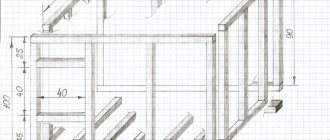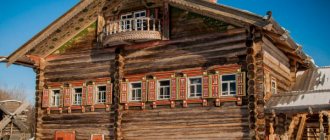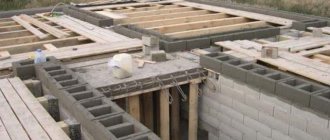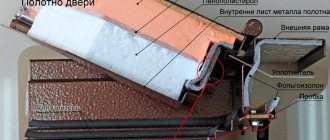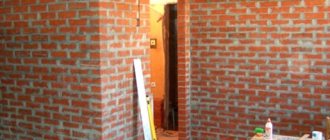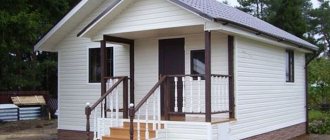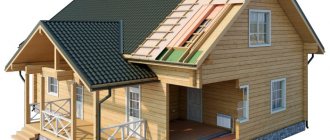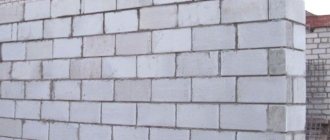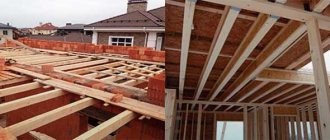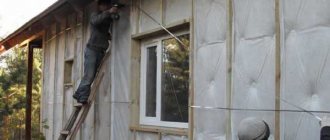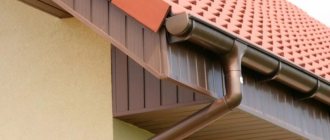The increase in utility tariffs in recent years has been quite large. This is especially reflected in heating prices. People living in private homes were simply forced to look for options that could help reduce costs.
The most optimal solution from a cost point of view is to insulate the walls from the outside, which reduces costs and makes the house more comfortable to live in during cold seasons.
This article will look at the best external wall insulation.
External wall insulation
Rating of the best external insulation materials
| Photo | Name | Rating | Price | |||
| TOP 3 models of expanded polystyrene foam | ||||||
| #1 | KNAUF Therm HOUSE | ⭐ 98 / 100 | Find out the price | |||
| #2 | Knauf Therm Wall Pro | ⭐ 97 / 1001 - voice | Find out the price | |||
| #3 | Knauf Therm Facade PRO | ⭐ 95 / 1002 — votes | Find out the price | |||
| TOP 4 models of extruded polystyrene foam | ||||||
| #1 | Carbon Eco TB | ⭐ 99 / 1002 — votes | Find out the price | |||
| #2 | Ursa XPS-N-III-L G4 | ⭐ 97 / 100 | Find out the price | |||
| #3 | TechnoNIKOL Technoplex | ⭐ 96 / 1001 - voice | Find out the price | |||
| #4 | Penoplex Wall | ⭐ 94 / 1002 — votes | Find out the price | |||
| TOP 5 stone wool models | ||||||
| #1 | Paroc Extra | ⭐ 98 / 1001 - voice | Find out the price | |||
| #2 | TechnoNIKOL Technovent Optima | ⭐ 97 / 1002 — votes | Find out the price | |||
| #3 | TechnoNIKOL TechnoFas Cottage | ⭐ 95 / 1002 — votes | Find out the price | |||
| #4 | Rockwool Facade Butts | ⭐ 94 / 1004 — votes | Find out the price | |||
| #5 | Rockwool Light Butts Scandic | ⭐ 94 / 100 | Find out the price | |||
What external wall insulation would you choose or recommend?
Take the survey
The best foam insulation
The material is obtained by foaming a polymer, but differs from the previous group of products in the rating due to its larger cells. This technology is easier to implement, so home insulation is cheaper, but the density is one of the lowest.
Knauf Therm House
Rating: 4.9
The first place in the ranking was taken by a product from a well-known brand, the name of which directly indicates its intended use - home insulation. Suitable for laying in floors along joists, insulating pitched roofs, and laying in wall niches. It is environmentally friendly and does not emit harmful gases into the room during operation. The manufacturer claims a service life of up to 100 years. The product is manufactured in accordance with GOST 15588-2014 and has quality certificates. Unlike extruded types, this one is not attractive to rodents.
The insulation is rated by experts as the lightest - the weight of a 100x60 cm sheet with a thickness of 5 cm is 400 g. This is the best option for finishing the walls of a house if the masonry already puts a large load on the foundation and a minimum mass is required from the insulating layer so as not to cause damage to the foundation . But due to the rigid structure, the craftsmen in the reviews advise insulating the seams with polyurethane foam to eliminate “cold bridges”.
Advantages
- the lowest price in the entire product rating;
- a light weight;
- many options for the cross-section and size of the slabs;
- not afraid of water.
Flaws
- density is only 10 kg/m3;
- burns and emits toxic smoke;
- crumbles during installation;
- You need to cut accurately and additionally insulate the seams with sealant.
PSB S 15-O
Rating: 4.6
In second place in the ranking is a product of a domestic manufacturer, produced with a density of 10 kg/m3. This results in light weight and minimal cost, which many users like in reviews. But the tensile strength of the frozen foam is small and amounts to 0.05 MPa when compressed, and if you try to bend it, the material breaks. The thermal conductivity of the insulation is average - 0.042 W per meter per Kelvin. But installation does not require numerous jumpers and fixation points, so it takes less time to lay brickwork in the house. The plate can be located in any spatial position.
We added insulation to the rating as having the widest range of sizes. Polystyrene foam is available in dimensions of 1x1 m, 1x1.2 m, 1x2 m, which is convenient for quick installation into the walls of a house in order to immediately cover a large area. Upon request, the manufacturer can provide other sizes required by the user.
Advantages
- resistant to aging;
- not exposed to moisture;
- do not spoil microorganisms;
- environmentally friendly.
Flaws
- low density 10 MPa;
- on sale it is designated in the old GOST (PSB-S15) and in the new way (PPS-10), which leads to confusion;
- burns strongly on contact with fire;
- Additional sealing of joints is required.
TOP 3 models of expanded polystyrene foam
Knauf Therm Facade PRO
Knauf Therm Facade PRO
Main properties:
- coefficient (k-t) of vapor permeability of the material – 0.026 mg/m*h*Pa;
- thermal conductivity of the material – 0.038 W/(m*K);
- degree of flammability – G3;
- density – 17 kg/sq.m.
The top three should start with the Façade model from the German company Knauf. It is implemented in the form of rectangular slabs. Thanks to a special production technology, the manufacturer will eliminate shrinkage of the slabs not only during, but also after installation.
This material is proposed to be used for insulating the walls of a private house, summer cottage, as well as various non-residential premises.
Excellent moisture resistance indicators will allow this material to be used in any, even the most humid, climatic conditions. Environmental friendliness and compactness are two more criteria why this model is worth paying attention to.
pros
- good quality of the final product
- environmentally friendly material that is not harmful to health;
- excellent heat-shielding properties;
- light weight;
- moisture resistant.
Minuses
- not detected.
Knauf Therm Facade PRO
Knauf Therm Wall Pro
Knauf Therm Wall Pro
Features:
- vapor permeability value of the material – 0.026 mg/m*h*Pa;
- thermal conductivity of the material – 0.042 W/(m*K)
- flammability group – G3;
- density – 12 kg/sq.m.
Next is another model of the Therm series. Energy-efficient boards are made on the basis of polystyrene foam, taking into account all the strict requirements established by the German company. This material has not only high strength, but also obvious hydrophobic properties. They will provide good insulation for private houses, summer cottages and office premises.
This insulation model is usually used for thermal insulation of a three-layer brick wall. The slabs from this company are laid after laying two layers of brick, and only after that the third layer of brick can be installed as a finishing touch.
Important! In addition to a brick wall, this model can be placed on reinforced concrete panels.
Environmental friendliness and safety are the main principles used by the manufacturer when creating these slabs. They contain no toxic or flammable reagents - only natural ingredients.
pros
- does not sag;
- environmentally friendly material;
- does not change shape even after time;
- has high heat-protective properties;
- moisture resistant.
Minuses
- not detected.
Knauf Therm Wall Pro
KNAUF Therm HOUSE
KNAUF Therm HOUSE
Characteristics:
- vapor permeability value of the material – 0.032 mg/m*h*Pa;
- thermal conductivity of the material – 0.042 W/(m*K)
- flammability group – G3;
- density – 10 kg/sq.m.
This universal insulation from Knauf is perfect for a private home or summer cottage. It is made from environmentally friendly polystyrene foam, which does not contain flammable or simply harmful elements. They insulate roofs, external walls, attics, interfloor ceilings and even floors.
pros
- versatility;
- environmentally friendly material;
- high heat-shielding properties;
- moisture-resistant material;
- withstands loads of up to 7 tons per 1 m².
Minuses
- not detected.
KNAUF Therm HOUSE
How to choose insulation for your home
Our rating contains the most popular types of insulation. Before considering it, we will briefly touch on the main parameters that you should pay attention to when choosing:
- Thermal conductivity
. The indicator informs about the amount of heat that can pass through different materials under the same conditions. The lower the value, the better the substance will protect the house from freezing and save money on heating. The best values are 0.031 W/(m*K), the average values are 0.038-0.046 W/(m*K). - Vapor permeability
. It implies the ability to pass particles of moisture through (breathe) without retaining it in the room. Otherwise, excess moisture will be absorbed into the building materials and contribute to the appearance of mold. Insulation materials are divided into vapor-permeable and impermeable. The value of the former ranges from 0.1 to 0.7 mg/(m.h.Pa). - Shrinkage.
Over time, some insulation materials lose volume or shape due to their own weight. This requires more frequent fixation points during installation (partitions, clamping strips) or use them only in a horizontal position (floor, ceiling). - Mass and density.
The insulation characteristics depend on the density. The value varies from 11 to 220 kg/m3. The higher it is, the better. But as the density of the insulation increases, its weight also increases, which must be taken into account when loading building structures. - Water absorption (hygroscopicity).
If the insulation is exposed to direct water (accidental spillage on the floor, roof leakage), it can either withstand this without harm, or become deformed and deteriorate. Some materials are not hygroscopic, while others absorb water from 0.095 to 1.7% by weight in 24 hours. - Operating temperature range
. If the insulation is placed in the roof or directly behind the heating boiler, next to the fireplace in the walls, etc., then maintaining the elevated temperature while maintaining the properties of the material plays an important role. The value of some varies from -60 to +400 degrees, while others reach -180...+1000 degrees. - Flammability
. Insulation materials for the home can be non-flammable, low-flammable and highly flammable. This affects the protection of the building in the event of an accidental fire or intentional arson. - Thickness.
The cross-section of the layer or roll insulation can be from 10 to 200 mm. This affects how much space will need to be allocated in the structure for its placement. - Durability
. The service life of some insulation materials reaches 20 years, and others up to 50. - Easy to install.
Soft insulation can be cut a little oversized and it will tightly fill a niche in the wall or floor. Solid insulation materials must be cut exactly to size so as not to leave “cold bridges”. - Environmental friendliness.
Implies the ability to release vapors into the living space during operation. Most often these are binder resins (of natural origin), so most materials are environmentally friendly. But during installation, some types can create an abundant dust cloud, harmful to the respiratory system, and prick your hands, which will require protection with gloves. - Chemical resistance.
Determines whether it is possible to lay plaster over the insulation and paint the surface. Some species are completely stable, others lose from 6 to 24% of their weight when in contact with alkalis or an acidic environment.
Why is external insulation better than internal insulation?
Insulation of the house has always been considered an important aspect: without this, the house will not be warm in the winter, nor will it be possible to enjoy the cold in the summer. Houses are usually insulated from the outside. The standards are specified in SP 23-101-2004.
Internal insulation options have one very unpleasant point - they take up free space in the room. Of course, the document does not prohibit insulating a house from the inside, but this should be done only in extreme cases, when it is simply impossible to insulate the outside.
Insulation from the inside, in addition to reducing free space, carries another disadvantage - rapid failure due to exposure to moisture, so most often when insulating the inside of a room, another layer is installed - a vapor barrier.
The result of the comparison is as follows: it is better to insulate a house from the outside than from the inside.
The best basalt insulation
This category of insulation in the rating is also called stone or mineral wool. It is obtained by melting basalt rocks, during which thin fibers are formed. The substance is completely natural, and natural resins are used for the binder.
Rockwool
Rating: 4.9
In first place in the ranking of basalt insulation for the home is the product of a company from Denmark. Cotton wool is produced in rolls and slabs, which is convenient for installation on joists or when laying in walls. The material can be used for both internal and external insulation of a house. In terms of thickness, the manufacturer offers options from 50 to 100 mm with a density of 37 kg/m3. Stone wool is completely non-flammable and safe for residential premises. Masters in reviews share that you can buy it in various packaging, 6-12 sheets per package, which is practical for different volumes of work. The insulation is suitable for all building materials in the house. Cotton wool fibers can withstand temperatures up to 1000 degrees, so even the walls of a fireplace can be lined with it.
Our experts liked the home insulation because of the new Flexi technology. One of the edges of the sheet has a spring property and is further expanded after installation. This edge is specially marked by manufacturers and improves the tightness of the installation, which is why the product was included in the rating of the best.
Advantages
- does not crumble during installation;
- excellent sound insulation;
- easy to install;
- low weight with a density of 37 kg/m3.
Flaws
- the whole body itches a lot after styling;
- thermal conductivity increases when wet;
- absorbs water up to 1 kg per m2;
- More supports are needed for vertical installation.
Hotrock Smart
Rating: 4.8
In second place in the ranking is a product from a Russian manufacturer. This insulation is produced in the form of slabs 50-100 mm thick and has a thermal conductivity index of 0.036 W/(m*K). During its production, organic substances (resins) of no more than 2.5% were used, so during operation no odors are released into the house. The insulating layer is completely non-flammable and can be used as a fire barrier in metal doors.
We included the insulation in the rating of the best due to the good combination of price and quality, which buyers agree with in the reviews. The company guarantees the service life of insulation in a house for up to 50 years. The production of basalt slabs is carried out using German equipment, and a new furnace is used to melt the rock, which ensures good quality at an affordable price. The material also has a compressibility of up to 50%, versus 30% for competitors, so the masonry is especially dense and the insulating layer takes up less space in the room.
Advantages
- light weight - with dimensions of 1200x600 mm, the slab weighs less than a kilogram;
- does not burn at all;
- low thermal conductivity;
- has three safety certificates in Russia;
- Suitable for cold attics, pitched roofs and floor insulation.
Flaws
- water absorption 1.5%;
- loses its shape without proper fixation;
- density 22 kg/m3 loses to competitors;
- not recommended for house walls.
Pros and cons of external insulation
Insulating the exterior is a useful method of retaining heat and reducing costs in the long run.
This option has both advantages and disadvantages, which should be equally taken into account. Let's look at them below.
| pros | Minuses |
| The room remains warm longer, which is important in the winter season | It takes longer to warm up the house due to the thermal insulation properties of the material |
| The temperature inside the house does not change, and if it changes, it is insignificant | |
| The insulation closes the seams in panel houses, which solves the problem of their sealing | It is very difficult to insulate a multi-storey building on your own - you need to seek the help of specialists |
| Insulation will greatly increase the service life, since the outer material will act as a protective layer |
External insulation has its pros and cons, which should be taken into account when choosing
The best fiberglass insulation
This type of product in the rating is popularly called glass wool. It is produced by melting soda, sand, borax, limestone and broken glass. This produces thick fibers with varying orientations that effectively inhibit heat transfer. The material is cheaper than its analogues, but it hurts your hands a lot during installation.
Isover Warm House
Rating: 4.9
In first place in this rating category is a product known throughout the world. Glass wool for the home is produced in rolls with a cross-section of 5 cm and a width of 55 cm. In production, the company uses patented TEL technology, which is highly environmentally friendly. The insulation is suitable for use in houses on pitched and straight roofs, in floors and wall partitions. The product complies with ISO9001 and EN13162 standards. In addition to heat insulation, it helps protect against noise. The thermal conductivity of the substance is 0.040 W/(m*K). Buyers in reviews note the affordable price and long service life with proper protection from water.
Our experts added insulation to the rating due to its convenient release form in rolls from 5.5 to 7 meters long. This is practical when filling walls in plasterboard partitions, in order to immediately close the space from floor to ceiling and make do with a minimum of cuts. The 50mm thickness is good for the profile width.
Advantages
- complies with hygienic standards (can be used in children's institutions);
- does not burn;
- entirely made from natural materials;
- elastic and does not require precise dimensions when cutting;
- allows steam to escape from the house to the outside.
Flaws
- does not hold its shape well;
- properties deteriorate when wet;
- inconvenient to lay;
- average thermal conductivity.
Ursa Geo
Rating: 4.8
In second place in the ranking of the glass wool category is a domestic brand, which is often used as a common noun when indicating the type of insulation. Now these products are known throughout the CIS and are in high demand. The thickness of home insulation varies from 5 to 10 cm, and the width of the roll is 120 cm. A square meter weighs 1 kg (with a cross-section of 10 cm), which is convenient for calculating the weight of load-bearing structures. Glass wool is allowed to insulate not only the walls, floor and roof of the house, but also chimney, heating, and ventilation pipes. The product belongs to fire hazard class KM0. Experts in the reviews like the vapor permeability of 0.64 mg/mhPa, but its thermal conductivity indicator is inferior to its analogues and is in the range of 0.040-0.046 W/(m*K).
The product is rated as the best for pitched roofs and floor insulation in the house, since it is also available in convenient rolls. The buyer can choose to have two rolls of 6 m each in one package, or one 10 m long. When installed in floors along joists, this allows one roll to be stretched immediately along the length of the room and saves time.
Advantages
- glass wool does not burn;
- light weight simplifies transportation and installation;
- does not have a serious impact on the foundation;
- high sound insulation;
- compatible with wood, aerated concrete, foam blocks, brick.
Flaws
- low density 11 kg/m3;
- gets wet and changes shape;
- inconvenient to lay due to increased causticity.
Commonly used insulation materials for outdoor use
Construction stores today offer a wide range of thermal insulation products. The three most popular materials are:
- expanded polystyrene foam (international designation - EPS);
- extruded polystyrene foam (international designation - XPS);
- stone wool.
Expanded polystyrene foam
It is considered a fairly popular option. Presented in the form of solid slabs. Their density can be different, which directly affects thermal conductivity.
The structure of this material is small balls with air inside, which are tightly fastened together, which provides excellent thermal insulation in the house.
Foamed polystyrene foam has good moisture resistance and strength. Also considered low flammable.
And yet this material has disadvantages. There are only two of them:
- when burning, it can release large amounts of toxic gas;
- they cannot insulate walls made of “breathable” material.
Example of expanded polystyrene foam
Extruded polystyrene foam
This material has some similarities with expanded polystyrene foam in terms of composition. The difference is in the production technology, thanks to which this material has a cellular structure.
In terms of home insulation and water absorption, this material is superior to expanded polystyrene foam.
Important! This material also stands out for its greater strength and lower vapor permeability.
It is precisely because of the properties of this material that it is used to insulate a house from the outside, although the disadvantages of it and the foam version are exactly the same.
Example of extruded polystyrene foam
Stone (so-called basalt) wool
The third most popular type of building material is basalt wool.
The design of the slab hints at reduced thermal conductivity. The reason for this is the structure - it is fibrous and has a low density. Such material, interestingly, is not exposed to fire or decay. Interestingly, it is considered “breathable,” which means it allows air to pass in or out, preventing the appearance of fungus.
Example of stone wool
Important! This wool has a “relative” in the form of glass wool, but it is used less often as insulation.
The best insulation materials in slab and roll formats
Rolls and more familiar slabs top the ranking of the most popular types of insulation. They allow you to significantly save on paying for the services of professional workers both outside and inside the house. This is achieved by the ease of self-installation of the material. When working with insulation, it is important not to forget about the possibility of cold bridges through which heat can escape from the home.
Foam glass
Foam glass is one of the most effective and most modern heat insulators. Its panels are composed of cells with a solid texture. They are ideal for thermal insulation of walls, foundations, and spaces under the roof. In European countries, building blocks are made from foam glass, which are very popular for building walls. In our country, panels are often attached from the outside to brick or concrete bases. Thanks to the presence of a whole list of useful qualities, foam glass will help protect your home not only from low temperatures, but also from extraneous sounds. Sound absorption rate - up to 56 dB. The insulation is not able to absorb moisture, it is not afraid of biological damage and is very resistant to temperature changes. Other positive qualities of foam glass include high thermal insulation properties, natural origin, chemical resistance, and long service life.
But in private housing construction, the material is not in very high demand due to its high cost.
Glass wool
Glass wool has been known in the construction industry for decades. Thermal insulating material is the result of the melting process of various minerals - sand, limestone, soda, dolomite and broken glass. Glass wool was especially often used as insulation for wooden houses. And all because it represented a good barrier from rodents. With its help, they still continue to build buildings - frame or wooden. Slab and roll versions of the material are available for sale. When working with this heat insulator, it is important not to forget about compliance with safety precautions. It is recommended to use gloves, safety glasses and a respirator.
Expert opinion
Konstantin Alexandrovich
Glass wool, although considered an obsolete material, is still used due to its certain advantages. These include its fire resistance, versatility, high ability to insulate from cold, ease of installation and affordable cost. The disadvantages of glass wool include its brittle fibrous structure, which can cause significant shrinkage and pose a health hazard.
Sandwich panels made of extruded polystyrene foam
Often, large heat losses from living spaces occur through window structures. To avoid this problem during construction or repairs, it is recommended to insulate slopes. A sandwich panel made of extruded polystyrene foam is an extremely effective method of thermal insulation. It not only prevents heat loss, but also allows you to give the window opening a finished, neat look. The composition of such a panel includes polystyrene foam, the thickness of which is 10 millimeters. The material is located between two thin layers of plastic. The advantage of such slopes is their moisture resistance, which means they are not afraid of fungi and mold. In addition, the use of a sandwich panel allows you to complete the work in the shortest possible time. The delivery time for windows with slopes made of sandwich panels can be as little as one day.
Expanded polystyrene sandwich panels are becoming an increasingly popular material for thermal insulation. Among the advantages, professionals note the speed of designing window openings, high resistance to moisture, environmental friendliness and long service life. There is only one drawback - the high cost.
Styrofoam
Foam plastic has been and remains one of the most popular materials in private housing construction. This demand is caused by the affordability of insulation and its excellent insulating properties. Lightweight white panels are produced by foaming polystyrene with steam. Professionals consider one of the most important advantages of polystyrene foam to be its water resistance. Thanks to this property, fungus and mold may not appear over the years. In addition, the heat insulator does not shrink during operation, holds its shape well, and is easy to install and further finish. When choosing polystyrene foam, it is important to consider the degree of its density. It can be used to insulate walls made of brick, wood, gas silicate, and as a layer under siding.
Among the advantages of polystyrene foam are impermeability to moisture, light weight, low thermal conductivity and ease of installation. Obvious disadvantages are a high degree of flammability, increased fragility and poor sound insulation properties.
Mineral wool
Mineral wool is one of the most versatile materials for thermal insulation used by professionals. This insulation is successfully used for external and internal insulation. The heat insulator is perfect for finishing walls, interior partitions, floors and ceilings, as well as roofing. Mineral wool is produced from basalt or metallurgical slag, which goes through a powerful press and high-temperature treatment. Therefore, you can often hear names such as stone or basalt wool. The fibrous structure of the material is filled with air, which allows the formation of a protective layer against the cold masses in the home. Mineral wool is produced in slab or roll form.
Mineral wool has been known on the building materials market for a long time and has won many adherents. Among the advantages of insulation are its affordable cost, reduced thermal conductivity, long service life, fire resistance and environmental friendliness. The main disadvantage is the hygroscopicity of the material.
Other external insulation materials
Today, in addition to the above options, you can find alternative insulation options in construction stores:
- polyurethane foam;
- "Teplover"
- ecowool;
- liquid ceramic insulation.
Polyurethane foam
This material is a familiar polyurethane foam. As a rule, it is used to seal cracks during the construction of building structures.
Polyurethane foam (another name is PPU) is a good option when the task is to insulate a house and create a seamless surface.
It is worth noting that it is better not to install such material yourself - this should be entrusted to specialists who will carry out high-quality work on insulating the outside of the house using special equipment.
Important! Previously, only professional equipment was used to apply such material, but now it can be bought in the form of an aerosol that anyone can handle.
pros
- absence of seams and joints - fastening such material allows you to achieve maximum integrity of the insulating structure, therefore the chance of seams and joints appearing is minimal;
- versatility - polyurethane foam “sticks” well to almost any material, from wood to concrete;
- long service life - deterioration of properties of polyurethane foam appears at least after a quarter of a century;
- self-extinguishing - this material has a very low flammability rate, which means it will not be able to maintain combustion.
Minuses
- poor holding power.
Polyurethane foam is a fairly popular material used as insulation.
Ecowool
Quite an interesting material that can be used for insulation. It stands out for its naturalness: 80% - cellulose, 20% - boric acid/borax.
Ecowool is applied in three different ways:
- Manual.
- Mechanized.
- Wet styling.
In the first case, such cotton wool is applied using improvised tools. The second option involves the use of a blow molding unit. The third requires the application of an adhesive binder and cellulose wool using a special nozzle and a water supply unit.
pros
- environmental friendliness - the material will not harm health because it is natural;
- ease of preparation - you just need to stir everything and the material is ready for application;
- ease of installation - even a beginner in the field of repair and construction can cope with the application.
Minuses
- not detected.
Ecowool - natural high-quality material for wall coverings
Teplover
It is considered a relatively new material. It is a plaster made on the basis of minerals such as vermiculite and perlite. The mixture stands out because, in addition to thermal insulation properties, it also has sound insulation properties.
This material has advantages and disadvantages that are worth considering.
pros
- durability;
- ease of preparation;
- high reliability;
- allows the wall to “breathe”;
- non-flammability - can withstand temperatures of more than 1000 degrees Celsius.
Minuses
- price – such material is quite expensive;
- complex application technology.
Important! It may be difficult to insulate a house with such a mixture on your own, so insulation with Teplover should be done by professionals with special equipment.
Heatover is a modern development that will satisfy the needs of most buyers
Liquid ceramic insulation
This type of thermal insulation can be used not only inside, but also outside the house. Externally, it is a liquid suspension (in some cases even a paste), resembling acrylic paint in consistency and appearance.
The basis of “liquid insulation” is a water-acrylic mixture. It is not only distributed evenly, but also spreads in a thin elastic layer over the entire surface.
The most important component of this suspension is ceramic spherical microgranules, the voids of which are filled with vacuum. It is these granules that provide not only heat preservation, but also a reduction in heat loss.
Important! Liquid insulation is somewhat reminiscent of a thermos in its functions.
In addition to granules, the water-alkyd mixture includes silicone, rubber and other additives. They will strengthen the insulation and reflect IR and UV radiation.
Let's consider the pros and cons of the material.
pros
- unable to burn;
- relatively environmentally friendly material;
- It is quite easy to apply due to the liquid form of the insulation.
Minuses
- The cost of this type of insulation is quite high.
Liquid insulation is the most technologically advanced and fresh variation of thermal insulation
New insulation materials used for external walls
Relatively new insulation materials used for external insulation are:
- polyurethane foam;
- ecowool.
Polyurethane foam
Polyurethane foam is the same polyurethane foam that is used to seal cracks in building structures.
The material is most often used for the manufacture of sandwich panels and thermal panels for facades. The sprayed option is convenient to use when it is necessary to create a seamless insulation surface. Previously, it was applied only using professional equipment. Now you can buy this material in the store in the form of an aerosol - this is a one-component variety for household use.
The disadvantage of this material is its low holding capacity. It cannot be used in wet façade systems.
Application of polyurethane foam.
Ecowool
A new insulation material made from cellulose fiber. It is applied to walls using a special apparatus. Warming is carried out in two ways:
- Filling the space between the wall and the facing material.
- Spraying together with an adhesive binder onto a wall with sheathing, followed by covering with façade panels.
Wet method of applying ecowool.
About the choice of insulation - just a complicated matter
You need to choose insulation depending on two factors: what the wall is made of and what the finishing will be.
Let's look at the main options below.
Brick walls
Wet facade
Clause 8.5 of SP 23-101-2004 says the following: vapor permeability of the inner layer (insulation) < vapor permeability of the outer layer (finishing). In other words, the insulation has one task - to help the walls ventilate moisture.
The best option in this case would be mineral wool. The reason for this choice is high vapor permeability. An alternative option would be polystyrene foam + a layer of plaster, since brick walls are not very good at removing moisture.
Facing brick
If for the finishing treatment of brick walls the choice fell on facing brick, then you can use expanded polystyrene in its two variations and stone wool.
Important! If stone wool is used, then you need to create a small but ventilated air gap. In this case, the water will evaporate, and the walls will not get wet.
An example of laying thermal insulation on a brick wall with facing brick finishing
Ventilated facade
If you don’t use facing bricks for cladding a brick wall and don’t make a wet facade, then you should take a closer look at the advice of professionals. They may suggest using porcelain stoneware in the form of large slabs. You can also use wall panels as a finishing treatment. In addition, it is often suggested to use stone wool as insulation.
An example of laying thermal insulation on a brick wall with a ventilated façade finish
The best polystyrene foam insulation
Extruded polystyrene foam is produced by foaming polystyrene. As a result, a frozen foam with small cells isolated from each other is formed. Thin walls do not allow the active transfer of temperature, due to which the insulation effect occurs.
Technicol XPS Technoplex
Rating: 4.9
In this category of insulation, the first place is occupied by a product known for its white and green packaging. Home insulation is produced in Russia. The material is produced in the form of slabs with a thickness of 20 to 100 mm, which the craftsmen like in the reviews, since it allows you to choose the optimal cross-section for different parts of the house. The use of thermal insulation in the bathroom and kitchen is allowed because it is capable of transmitting steam with a coefficient of 0.01 mg/(mhPa). At the same time, the surface does not absorb water, preventing the development of fungus.
Our experts liked the insulation due to its compressive strength of 0.1 MPa at a deformation of 10%. This allows you to insulate the floors along the joists and not worry about the load placed on them. It can also be used when organizing heated floors in a house with pipes or cables. This effect was achieved by adding nanocarbon, visible as a light gray tint. For this, the product was rated as the best for floor insulation.
Advantages
- wide range of thickness from 20 to 100 mm;
- low thermal conductivity 0.032 W/(m*K);
- L-shaped edge for easy installation under structures;
- almost does not absorb water (0.1%);
- high vibration resistance.
Flaws
- high price;
- the substance burns and smokes heavily;
- produced only in slabs.
Penoplex Comfort
Rating: 4.8
In second place in the ranking is another domestic insulation material used for sound and heat insulation of a house. Extruded polystyrene foam has a thickness of 3-5 cm and is produced in sheets of 118x58 cm. Sold in packs of 4-12 sheets. The thermal conductivity coefficient is close to the minimum and amounts to 0.033 W per meter per Kelvin. The manufacturer assures the versatility of the insulation both in terms of spatial placement and temperature range. The substance does not deteriorate from precipitation and has a compressive strength of up to 0.18 MPa. But users share in their reviews that the material can be damaged by rodents in the house, so you should first remove them and then install them.
We noted this insulation in the rating as optimal for thermal insulation of a balcony in a two-story house, a veranda or an enclosed terrace. The product is designed to maintain its properties even at a temperature of -50 degrees, so it is suitable for use in unheated rooms. Experts in reviews recommend it for both internal and external insulation of the house.
Advantages
- holds its shape well;
- universal in application;
- easy;
- lasts up to 50 years;
- does not deteriorate from water and frost.
Flaws
- Do not lay next to heating sources that produce temperatures above 75 degrees;
- high price;
- flammable material;
- Precise cutting required.
Walls made of aerated concrete blocks
Wet facade
According to paragraph 8.5 of SP 23-101-2004 and taking into account the fact that the wall is made not of brick, but of aerated concrete blocks, it would be better to use stone wool. If the premises are well ventilated from the inside, then polystyrene foam can be installed.
Facing brick
When a wet facade is not satisfactory, you can choose another option - facing bricks. Then not only stone wool, but also polystyrene foam can act as insulation.
Important! If you choose stone wool, then you simply need to install a ventilation gap between the facing brick and the insulation so that the moisture evaporates.
An example of laying thermal insulation on an aerated concrete wall with facing brick finishing
The best polyester fiber insulation
Polyester fiber is produced by recycling plastic containers and other raw materials, which helps preserve the environment. The result is multidirectional synthetic fibers that transmit steam well, but retard heat transfer. In appearance and characteristics, the substance is similar to padding polyester.
Shelter EcoStroy ShES Arctic
Rating: 4.9
This is the newest product in the ranking, produced using MicroFiber technology. The insulation is obtained with multidirectional fibers, creating an elastic layer with a constantly maintained shape. The effect of firba is the easy passage of steam. Nanotechnology has also been used to achieve a hollow structure of the villi, which allows for better temperature retention and sound absorption. The substance is hypoallergenic and does not contain phenol. According to environmental indicators, purity is 100%. Thermal conductivity is at a minimum level - 0.031 W/(m*K), which customers like in reviews. The insulation does not rot and is not of interest to rodents.
Our experts included the product in the rating as the best for insulating a home in a cold region, which is confirmed by the name “Arctic”. 100 mm of this material is replaced in terms of efficiency by 125 mm of mineral wool, so it will be possible to achieve high thermal insulation with a smaller layer thickness.
Advantages
- low thermal conductivity;
- water-repellent properties;
- does not rot and is not attractive to rodents;
- service life 50 years;
- Requires less thickness compared to other materials.
Flaws
- high price;
- weak, but supports combustion;
- releases harmful smoke when ignited.
Voting: the best external insulation for walls
What external wall insulation would you choose or recommend?
KNAUF Therm HOUSE
0.00% ( 0 )
Knauf Therm Wall Pro
5.88% ( 1 )
Knauf Therm Facade PRO
11.76% ( 2 )
Carbon Eco TB
11.76% ( 2 )
Ursa XPS-N-III-L G4
0.00% ( 0 )
TechnoNIKOL Technoplex
5.88% ( 1 )
Penoplex Wall
11.76% ( 2 )
Paroc Extra
5.88% ( 1 )
TechnoNIKOL Technovent Optima
11.76% ( 2 )
TechnoNIKOL TechnoFas Cottage
11.76% ( 2 )
Rockwool Facade Butts
23.53% ( 4 )
The main mistakes when choosing insulation for walls
Let's look at the main mistakes when choosing thermal insulation materials. This will save you from unnecessary expenses and rework.
- Saving. A low-quality thermal insulator will not only quickly become unusable, but will also compromise the integrity of the wall. Poor insulation can cause mold, mildew, or even the collapse of part of the façade. Therefore, when choosing insulation, you should not take the cheapest product in the store.
- Fire safety. The insulation must not only be non-flammable or low-flammable, but also environmentally friendly. When choosing between synthetic and natural insulation, give preference to the latter.
Common types of insulation
Before you go shopping for the best thermal insulator, you should decide what type of insulation you want to use: internal or external.
If we are talking about insulating a private building, then any specialist will advise you to use external thermal insulation. This is due to the fact that this method does not reduce the usable area of the room, there are no cold bridges, and the walls are protected from environmental influences.
If you need to insulate an apartment, then only the internal option is suitable, using thin insulation for the walls, since in an apartment, every centimeter of usable space counts.
Thermal insulators that the modern market offers are suitable for any type of insulation, so it is selected based on needs and necessity.
If the thermal insulation for the walls is chosen correctly, then in winter the house will not be cold, drafts and coolant losses will be eliminated.
How to deal with the shortcomings of internal insulation
The Building Regulations do not recommend using insulation from the inside when designing the thermal insulation of premises. However, if internal insulation is necessary, the thermal insulation layer must be continuous and durable.
To prevent the occurrence of dampness, the place where the dew point is located should be isolated as much as possible from the effects of vapors.
For this purpose, a set of measures is provided:
1. Use of insulation with minimal vapor permeability. It is necessary that this characteristic of the material be less than that of the wall. The main rule is that the vapor permeability of layers in a multilayer structure should increase from the inside out. In this case, the moisture will gradually come out.
A - vapor barrier decreases from inside to outside; B - vapor barrier increases from inside to outside.
2. High-quality installation. It is recommended to lay the insulation with glue, and the adhesive is applied not pointwise, but over all surfaces (under the comb) in order to avoid leaving gaps.
Applying glue to the insulation under the comb.
3. Equipping the room with additional ventilation. High-quality air exchange will help avoid humidity. It is necessary to use mechanical ventilation systems or install control valves on windows.
Window ventilated valve.
4. Particular attention should be paid to cold bridges. When installing thermal insulation indoors, there is no opportunity to insulate the joints of external walls. Therefore, the insulator is laid over the adjacent walls. These projections can then be decorated with boxes.
5. Cover with a vapor barrier. If stone wool is used as insulation, then from the side of the room it must be hermetically sealed with a special vapor barrier membrane, and all joints are carefully sealed.
Installation of a vapor barrier membrane on top of the insulation.
Insulation of walls from the inside with polystyrene foam
Expanded polystyrene is objectively the most acceptable type of thermal insulation material for internal wall insulation. At the same time, only a special type of it should be used for internal thermal insulation - extruded polystyrene foam . The peculiarity of this building material is as follows:
- Increased density. Extruded polystyrene foam slabs are produced by the extrusion method - squeezing raw materials through a narrow nozzle of an extruder (special equipment) under pressure. The material forms a dense, airless structure and is characterized by increased strength, rigidity, and geometric accuracy.
- Almost zero vapor permeability. Installed as thermal insulation, XPS foam boards allow virtually no vapor to pass through them. Thus, this particular insulation is rational and suitable for internal thermal insulation. It becomes a natural barrier between the internal surfaces of the wall and the humid air in the room.
- Thermal insulation properties. Extruded polystyrene foam is characterized by an ultra-low thermal conductivity coefficient of about 0.037-0.041 W/m*K. It demonstrates excellent resistance to heat transfer, due to which the maximum insulation effect is achieved with a small thickness. At the same time, losses of useful volume from internal insulation are minimized.
- Low price. The material has an excellent cost-performance ratio.
Selection of extruded polystyrene foam for internal insulation
Extruded polystyrene foam boards differ in thickness and type of edge. For internal insulation, choose slabs with the following thickness:
- 2-3 cm for a small room area;
- 5 cm in large rooms;
- 10 cm when insulating a loggia balcony that is part of a living space.
The edge of the slabs is an important nuance that is always taken into account when choosing internal thermal insulation. Foam plastic slabs with a straight edge form a small gap when they meet, but still a gap. It is a natural bridge through which cold enters the room and vapor passes under the insulation.
For internal insulation, we recommend using only slabs with a locking joining system - L-edge . Due to this configuration, the thermal characteristics of the heat insulator are improved and vapor permeability is minimized.
Products suitable for internal insulation of houses and apartments include:
- TECHNONICOL CARBON ECO 1180x580x30 mm. Characterized by an optimal ratio of thickness and thermal insulation. Suitable for rooms with a small area, as it practically does not “eat up” square meters. Equipped with L-edge, has high heat transfer resistance.
- TECHNONICOL Technoplex 1180x580x50 mm. Equipped with excellent strength and thermal characteristics. It has an optimal thickness for insulating medium and large rooms and balconies.
- TECHNONICOL CARBON ECO 1180x580x100 mm. The most effective thermal insulation is achieved when installing such material. Equipped with an L-edge, it can be used for insulating open balconies and loggias, large rooms.
Installation of extruded polystyrene foam for internal insulation
Installation of this type of insulation is possible in two ways - using polystyrene foam glue or using dowels.
Dowel mounting:
- Fastening with dowels is carried out after preliminary arrangement of the vapor barrier. A metallized substrate, membrane or overlapping polyethylene film is installed on the wall.
- The seams are taped with aluminum tape to prevent steam from getting under the film.
- The slabs, pre-cut to size, are installed on the wall and fixed using plastic mushroom dowels with a plastic nail.
- The joints of the plates and the dowel heads are glued with aluminum foil.
- Finishing is carried out - plastering or cladding of gypsum boards.
Glue fastening:
- In this case, installing a vapor barrier is impossible, therefore, special attention is paid to the joints.
- You can use dry glue for polystyrene foam, for example, EK THERMEX or Yunis Teplomontazh. It is also permissible to use special glue in cylinders in the form of low-expansion foam.
- For better adhesion, the internal surfaces of the slabs are processed with a float until a rough surface is obtained.
- The glue can be applied evenly to the wall or in “bloops” on the slab along the edges and in the center.
- The plate is placed against the wall and pressed down. Flatness and level are checked at the same time.
- The joints are taped with aluminum tape.
- Finishing is in progress.
There is a combined method of fastening using glue and dowels. But it is rational for external insulation of a room. The foam inside will not experience increased stress. Therefore, it is enough to choose one of the options.
Features of internal insulation of a house: what is important to know first
The main and hidden “enemy” of internal insulation is condensation. The air around us contains vapors in different concentrations. As a rule, in residential premises the concentration of vapors is often high. This is due to cooking in the kitchen, using bathrooms, watering flowerpots, wet cleaning and other reasons. Excess moisture is always removed through ventilation ducts and open windows. But in addition, they penetrate into the walls due to the porosity of the materials. When passing the wall, the vapor molecules necessarily collide with a conventional line, at which they turn into a liquid state - they condense. This line is called the "Dew Point".
With internal insulation, the dew point will always be located immediately behind the installed thermal insulation - that is, on the inner surface of the wall. When steam hits the wall, it forms condensation and moistens the wall material. The consequences of this are sad: immediately behind the insulation, a zone is formed with ideal conditions for the growth of bacteria, fungi, and mold. Thus, the premises may even become dangerous for living.
Based on what was described above, we conclude that the main task with internal insulation is to do everything possible to prevent contact of moist air with the dew point. That is, task No. 1 is to protect the inner surface of the wall from the slightest contact with steam . And this can be done quite simply. You need to do three things:
- follow the insulation installation technology;
- be sure to install a vapor barrier;
- choose the right material for wall insulation.
